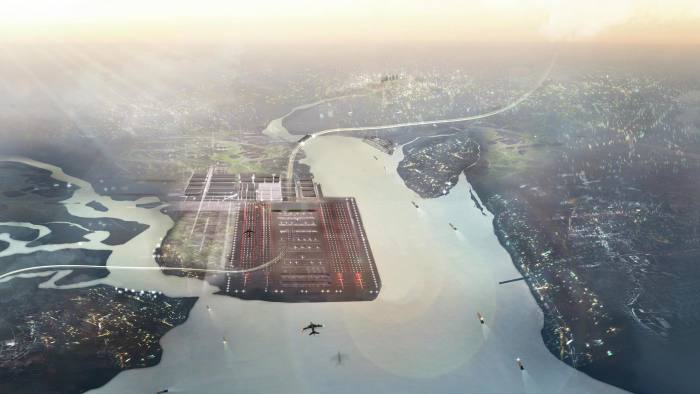Much ridicule has been directed at reports that Boris Johnson is eyeing not just one tunnel to link Scotland and Northern Ireland, but another three, which would converge in a giant roundabout under the Isle of Man. Comparisons have been made to Hitler moving around imaginary armies in the last days of the Third Reich. Such scorn, though, contains a risk: that all drafts for Johnsonian infrastructure projects will be consigned to the cutting-room floor, just because the PM envisaged a few tunnels too far.
I happen to be a supporter – sometimes, it feels, rather a lone one – of national infrastructure projects. Their lacklustre reputation in the UK may be in part because we have so often been really bad at them (HS2 anyone? Crossrail?) but also because by habitually branding them ‘grands projets’, we treat them as alien accretions. Having lived in France, I have to ask: what is so wrong with the high-speed rail network, the Pompidou Centre, the fabulous (British-designed) bridge at Millau, and, yes, the now nearly 30-year-old Channel Tunnel?
Speaking of tunnels, Boris Johnson’s original proposal for a tunnel linking Northern Ireland to Mainland Britain must surely have some appeal. At a time when the trend is more towards separation than union, such a link has not only practical, but symbolic, value. The studies, already in progress, must continue.
Such a venture, though, should only be the start. If, as would appear from all the tunnel-talk, Number 10 is starting to revisit some of its pre-pandemic infrastructure plans, then there is one project crying out for revival. This is for a state-of-the-art London airport – and, yes, that means the supposed white elephant known as ‘Boris Island’ (more formally named ‘London Britannia’) or its one-time rival, the Thames Estuary Hub, designed by Norman Foster to bring together air, road, rail and sea transport.
Plans for the two projects were much further advanced when they were abandoned than the Stranraer-Larne tunnel project is now. And there should be political will aplenty. As chief advocate of an estuary airport all those years ago, the Prime Minister could surely dust off the case he made – compellingly – at the time.
In the end, the plans for an estuary transport hub bit the dust for several reasons. It was judged too expensive, too detrimental to local habitats, especially for marsh birds; plus business was reluctant to give up on Heathrow. It was closer to the capital than most other airports, and any move would require extensive new infrastructure, from housing, to transport and schools. It was decided to abandon the project and plump for a third runway and accompanying infrastructure at Heathrow instead. It precipitated a battle that is still not over.
But the balance of arguments could now look very different. Too expensive? How much has already been spent on mitigating the effects of Covid? The pre-eminence of Heathrow? Traffic is now at less than 25 per cent of what it was pre-pandemic and another two years or more could be needed before anything like previous levels return. Ecological considerations, especially to bird life? Of course, but harm to humans, especially children, from air pollution now looms as a far greater concern than it once did – which calls into question the new road systems needed for the expansion of Heathrow.
Air pollution from planes, as well as roads, was hardly measured before, but could become an issue now, as could noise – which affects millions living under the Heathrow flightpaths, not just in the capital’s western suburbs, but in densely populated parts of the centre. A rare upside of the pandemic, for those of us regularly woken up at 4am by the first flights into Heathrow being ‘stacked’ above central London, has been that these pre-dawn arrivals have been fewer and further between. It is hard now to envisage Heathrow’s third runway ever being needed – or, even if demand rebounds, that the cost-benefit calculations of a new runway would look the same as they did.
Earlier this month, France acknowledged the new landscape when it announced that its plan for a vast new terminal at Paris Charles de Gaulle airport had been shelved. Pandemic-related changes and new environmental priorities, the ecology minister said, had rendered the whole project ‘obsolete’. The same applies to any expansion of Heathrow. But it does not negate the case for a new London airport – rather, it strengthens the argument for shrinking if not actually closing Heathrow and building a new and far greener Thames Estuary hub instead.
Heathrow, as has often been pointed out, is poorly located for a major airport. It is prone to bad weather and requires take-offs and landings over some of the most densely populated areas in Europe. Now that the pandemic has cut traffic at Heathrow by at least three quarters, Boris Johnson has a unique and totally unforeseen opportunity not only to halt further Heathrow expansion, but to revive his brainchild of a new London airport. If Heathrow is to remain in business, it should be as a smaller, primarily short-haul city airport, such as Milan Linate or Washington National.
A new airport in the Thames estuary would provide more local jobs and improved infrastructure. Safety would be improved as landings and take-offs would be mostly over water; air and noise pollution would be diminished. It is hard to see what is not to like.
There is another reason, too, for embarking on a Thames Hub Airport now. Airports, for all the opprobrium that attaches to them, are tantamount to a national advertisement at the point of entry. They say something about where you have arrived. Many countries, especially in Asia, know this. The airports of Seoul and Singapore are models of style and efficiency; Hong Kong’s new airport was conceived in part as a statement of confidence in the territory’s future in the wake of the killings at Beijing’s Tiananmen Square. Tel Aviv, Copenhagen, Vienna and Venice all have modern airports that successfully combine function with a distinct sense of place.
London Britannia, with a 20-minute high-speed connection to central London and links to the Channel Tunnel, HS2 and perhaps to a cruise terminal, could be exactly what Global Britain needs. I recently heard Bob Zoellick, former President of the World Bank (among many other things) and a globe-trotter par excellence, set out a short menu for Brexit Britain. High on his list was: ‘You need a good airport… Heathrow is awful’. He is right. A good airport is an asset; an unattractive or dysfunctional airport can blight a country’s reputation faster than almost anything else: remember all the lost baggage when Heathrow opened Terminal 5? A lot of disgruntled international travellers still do.
A tunnel linking Northern Ireland to mainland Britain, and a splendid new London hub airport welcoming the world’s travellers to the capital and beyond – how better to show that, post-Brexit, post-pandemic, the UK is in business? Prime Minister, just get them done!






Comments